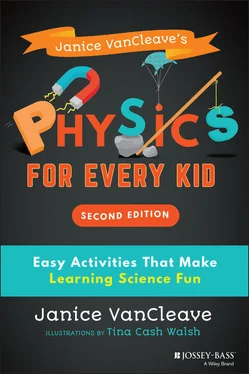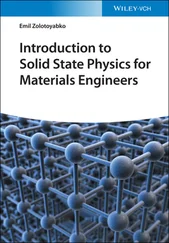Janice VanCleave - Janice VanCleave's Physics for Every Kid
Здесь есть возможность читать онлайн «Janice VanCleave - Janice VanCleave's Physics for Every Kid» — ознакомительный отрывок электронной книги совершенно бесплатно, а после прочтения отрывка купить полную версию. В некоторых случаях можно слушать аудио, скачать через торрент в формате fb2 и присутствует краткое содержание. Жанр: unrecognised, на английском языке. Описание произведения, (предисловие) а так же отзывы посетителей доступны на портале библиотеки ЛибКат.
- Название:Janice VanCleave's Physics for Every Kid
- Автор:
- Жанр:
- Год:неизвестен
- ISBN:нет данных
- Рейтинг книги:5 / 5. Голосов: 1
-
Избранное:Добавить в избранное
- Отзывы:
-
Ваша оценка:
- 100
- 1
- 2
- 3
- 4
- 5
Janice VanCleave's Physics for Every Kid: краткое содержание, описание и аннотация
Предлагаем к чтению аннотацию, описание, краткое содержание или предисловие (зависит от того, что написал сам автор книги «Janice VanCleave's Physics for Every Kid»). Если вы не нашли необходимую информацию о книге — напишите в комментариях, мы постараемся отыскать её.
Janice VanCleave's Physics for Every Kid: Easy Activities That Make Learning Science Fun, 2nd Edition
Physics for Every Kid
Physics for Every Kid
Janice VanCleave's Physics for Every Kid — читать онлайн ознакомительный отрывок
Ниже представлен текст книги, разбитый по страницам. Система сохранения места последней прочитанной страницы, позволяет с удобством читать онлайн бесплатно книгу «Janice VanCleave's Physics for Every Kid», без необходимости каждый раз заново искать на чём Вы остановились. Поставьте закладку, и сможете в любой момент перейти на страницу, на которой закончили чтение.
Интервал:
Закладка:
This book was designed to give the reader a taste of physics:
Energy Learn about stored energy, energy of moving objects and the transfer between them, and the study of different forms of energy including mechanical, electrical, sound, and light. Energy is simply the ability to do work, which means to change or deform or move an object, and to create heat.
Force and Motion Learn about the effect of forces acting on an object, and study about the force of gravity and how it affects falling objects. A study of Sir Isaac Newton's Three Laws of Motion and how they apply to our everyday lives is covered.
Simple Machines Learn about simple machines which are mechanical devices that change the direction and/or magnitude (size) of a force. Levers, inclined planes, wedges, wheels and axles, pulleys, and screws are studied.
Magnets Learn about magnets and their effect, including an invisible field around magnets responsible for the most remarkable property of a magnet, which is a force that pulls on other magnetic materials, such as iron, and attracts or repels other magnets.
The Activities
This book is written to guide you through the steps necessary in successfully completing a science experiment and to present methods of solving problems and making discoveries.
Introduction: Background information provides knowledge about the topic of the investigation and generally describes cause and effect relationships that you can investigate.
See for Yourself: A list of common but necessary materials and step-by-step instructions on how to perform the experiment is provided.
What Happened? A statement of the predicted outcome is provided with a discussion of what should have happened during the activity. A scientific explanation of what was observed is provided using understandable language and technical, scientific vocabulary so that readers of any age can master the scientific principles involved and discuss their findings.
General Instructions
1 Read first. Read each experiment completely before starting.
2 Collect needed supplies. You will experience less frustration and more fun if all the necessary materials for the experiments are ready and set up for easy access.
3 Experiment. Follow each step very carefully, never skip steps, and do not add your own. Safety is of the utmost importance. By reading the experiment before starting, you will be able to note any safety warnings. Then, follow instructions exactly so you can feel confident that your outcome will have the desired results.
4 Observe. If your results are not the same as described in the experiment, carefully reread the instructions, and start over from the beginning. Check to make sure your materials are as described and in good working order. Use the illustrations to see if the activity is set up properly. Consider factors, such as the ambient temperature, humidity, lighting, and so on, that might affect the results.
Measurements
Measuring quantities described in this book are given in imperial units followed by approximate metric equivalents in parentheses. Unless specifically noted, the quantities listed are not critical, and a variation of a very small amount more or less will not alter the results.
Foreword
Imagine a toddler gleefully dropping a bottle off the highchair tray. Their parent returns the bottle to its rightful place only to see it dropped again. And each time the bottle falls to the floor. This toddler and Sir Isaac Newton have something in common. They both find physics delightful! Janice VanCleave knows that this toddler is learning about the laws of physics! This book is written for every kid who wants to keep dropping things, rolling things, and, most of all, wants to keep learning about the physical world.
And who hasn't wondered about how something as large as an airplane can stay up in the sky? Janice VanCleave never wants that sense of wonder to end. Written for people of all ages with a curiosity about the world around us, this book will be a treasure for the homeschooling parent or classroom teacher that wants to add easy-to-do science that promises to have kids asking, “Is it time for science yet?”
Each activity starts out with a clear explanation of a scientific phenomenon. We have all played with magnets. But did you know that you can map an invisible magnetic force field with a compass? Soon, you find yourself eagerly gathering a few common household materials because the activity is so enticing you can't wait to try it! Each science activity, often deceptively simple, is followed by an explanation that uses everyday language to explain complex principles. It is simply astounding to experiment with something that you have seen a million times, but for the first time you really understand the science. Wow.
Janice VanCleave is a teacher at heart. Her true passion is explaining science in a way that anyone can understand it. This book is a treasure. It unlocks the mystery of physical laws that we see every moment of every day.
I can't help but think that one day the baby who dropped the bottle off the highchair tray will open this book. Then, a true adventure of science discovery and learning will take place. Once again, exploring physics will be delightful! Perhaps that kid will grow up to be the first person to walk on Mars. Anything is possible.
Mary Bowen
I Energy Introduction
Energyis the capacity to do work. In physics, work is done when a force is applied to an object causing it to move. A forceis a pushing or pulling action on an object. Forces are measured in pounds (lb) or newtons(N), where 1 lb = 4.5 N. Workoccurs only when a force causes something to move. If you push on a tree and it doesn't move, then no work has been done even though the effort may have exhausted you. Study how work is calculated in this important equation: W = F × d ; where W is the work done; F is a specific force and d is the distance moved. Comparatively, when the equation is W = F net× d , the work being done considers all forces ( F net) that are acting on the object that is being moved, including frictional forces. Weightis a measure of Earth's gravitational force pulling an object down toward the center of Earth. Gravity is the force of attractionbetween two objects with mass. Yes, your body has a force of attraction on other objects, but it is such a minute force that it is basically ineffective. Whereas, the mass of Earth is great enough to produce a force that pulls things on or near Earth's surface down. Down means toward the center of Earth; thus, when you drop something, it falls perpendicular to Earth's surface. Forces do not always cause linear motion, which is motion in a straight line. Torqueis a turning force that causes motion around a center point, such as the turning of a lid or the spinning of a merry-go-round.
Movementis the change of an object's physical position. Linear movement is measured in feet (ft) or centimeters (cm), where 1 ft = 30 cm. Not all movement is linear or rotational but rather some objects vibrate, meaning they move back and forth. Frequencyis a measure of the number of times something happens in a specific amount of time. Frequency can be measured in hertz( Hz), where 1 Hz = 1 cycle per second or one back and forth vibration.
Potential energyis the energy an object has because of its position relative to some zero position. It is energy that has the potential to do ‘work.’ Two types of potential energy investigated in this book are gravitational potential energyand elastic potential energy.
Читать дальшеИнтервал:
Закладка:
Похожие книги на «Janice VanCleave's Physics for Every Kid»
Представляем Вашему вниманию похожие книги на «Janice VanCleave's Physics for Every Kid» списком для выбора. Мы отобрали схожую по названию и смыслу литературу в надежде предоставить читателям больше вариантов отыскать новые, интересные, ещё непрочитанные произведения.
Обсуждение, отзывы о книге «Janice VanCleave's Physics for Every Kid» и просто собственные мнения читателей. Оставьте ваши комментарии, напишите, что Вы думаете о произведении, его смысле или главных героях. Укажите что конкретно понравилось, а что нет, и почему Вы так считаете.












